IMDEA Networks

Archivos: Events
Defensa Tesis Doctoral: A system for the detection of Limited Visibility in BGP
The performance of the global routing system is vital to thousands of entities operating the Autonomous Systems (ASes) which make up the Internet. The Border Gateway Protocol (BGP) is currently responsible for the exchange of reachability information and the selection of paths according to their specified routing policies.
Seguir leyendo arrow_right_altPrediction-based Optimization in Mobile Networks
A highly interesting trend in mobile network optimization is to exploit knowledge of future network capacity to allow mobile terminals to prefetch data when signal quality is high and to refrain from communication when signal quality is low. While this approach offers remarkable benefits, it relies on the availability of a reliable forecast of system conditions.
Seguir leyendo arrow_right_altNew Methods for Ranking Influence in Social Networks
In this work, propagation dynamics on social networks are studied in order to identify the most influential users. For this purpose, diffusion data has been collected during 4 weeks from a microblogging OSN (online social network) called Tumblr.
Seguir leyendo arrow_right_altThe Internet is not a good place
The Internet is a messy, complex landscape. Middleboxes such as DNS resolvers, UPnP home gateways, and in-path proxies placed in the IP core of the operators' networks can significantly
impair a user's access despite being designed for the contrary.
A Mathematical Approach to the Automatic Discovery of Interesting Questions
In this presentation we will explain a new mathematical procedure for the automatic discovery of interesting research questions. We propose to classify research topics according to their relevance (how important is the topic) and nescience (a measure of our current understanding of that topic).
Seguir leyendo arrow_right_altTransport Services - Internet Transport's Last Chance?
The Internet's Transport Layer has been defined by TCP and UDP for the last 30 years. The minimal functionality of UDP enables application developers to develop their own proprietary protocols - there are plenty of examples.
Seguir leyendo arrow_right_altInferring Coarse Views of Connectivity in Very Large Graphs
This paper presents a simple framework, called WalkAbout, to infer a coarse view of connectivity in very large graphs; that is, identify well-connected “regions" with different edge densities and determine the corresponding inter- and intra- region connectivity.
Seguir leyendo arrow_right_altNoche de los Investigadores 2014 – Tu coche y un F1: ciencia y tecnología del siglo XXI
El viernes 26 de septiembre de 2014, entre las 18:00 y las 21:00 horas, algunos investigadores de los Institutos de investigación IMDEA mostrarán al público que en un automóvil se pueden encontrar ejemplos de los avances experimentados por ciencias y tecnologías tan diversas y aparentemente poco relacionadas entre sí, como el software, la ciencia de materiales o la alimentación.
Seguir leyendo arrow_right_altModeling D2D Communications in Cellular Access Networks via Coupled Processors
We present a first fully analytical approach to performance evaluation of D2D communication systems, which does not assume transmitters to have always a packet to transmit. In particular, we adopt a Coupled Processors model to describe a cellular scenario with D2D users sharing radio resources with cellular users, i.e., adopting in-band underlay D2D schemes. We derive sufficient conditions for stability of such system, and we characterize the effects of D2D transmissions on cellular user performances.
Seguir leyendo arrow_right_altFrom Quality of Service to Chaos in wireless networks
With the increasing availability of configurable network equipments, the research has moved from proposals to improve quality of service in the wireless standards, to complete potential chaos when it becomes accessible to every user. In this talk we go through this evolution and discuss its impact on the network and on the user.
Seguir leyendo arrow_right_alt











Comentarios recientes